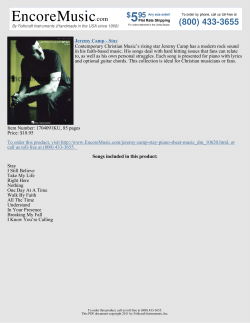
Center for Southeast Asian Studies, Kyoto University
http://englishkyoto-seas.org/ <Book Review> Janet Alison Hoskins Lauren Meeker. Sounding Out Heritage: Cultural Politics and the Social Practice of Quan Họ Folk Song in Northern Vietnam. Honolulu: University of Hawai‘i Press, 2013, 192p. Southeast Asian Studies, Vol. 4, No. 1, April 2015, pp. 195-198. How to Cite: Hoskins, Janet Alison. Review of Sounding Out Heritage: Cultural Politics and the Social Practice of Quan Họ Folk Song in Northern Vietnam by Lauren Meeker. Southeast Asian Studies, Vol. 4, No. 1, April 2015, pp. 195-198. View the table of contents for this issue: http://englishkyoto-seas.org/2015/04/vol-4-1-of-southeast-asian-studies Subscriptions: http://englishkyoto-seas.org/mailing-list/ For permissions, please send an e-mail to: english-editorial@cseas.kyoto-u.ac.jp Center for Southeast Asian Studies, Kyoto University Book Reviews 195 country earlier this year and what future may lie ahead for retrojected Thainess and Thailand. Kasian Tejapira เกษียร เตชะพีระ Faculty of Political Science, Thammasat University References Apichat Satitniramai อภิชาต สถิตนิรามัย; Yukti Mukdawijitra ยุกติ มุกดาวิจิตร; and Niti Pawakapan นิติ ภวัคร พันธุ.์ 2013. Thobthuan phumithas kanmeuang Thai ทบทวนภูมิทศั น์การเมืองไทย [Re-examining the political landscape of Thailand]. Bangkok: Thailand Universities Healthy Public Policy. Thai Health Promotion Foundation (Thai Health). Pasuk Phongpaichit; and Baker, Chris. 2004. Thaksin. Washington: University of Washington Press. People Information Center [ศูนย์ขอ้ มูลประชาชนผูไ้ ด้รับผลกระทบจากการสลายการชุมนุมกรณี เม.ย.-พ.ค. 53 (ศปช.)]. 2012. Khwamjing pheua khwamyutitham: Hetkan lae phonkrathob jak kansalai kanchumnum mesa่ ความยุติธรรม: เหตุการณ์ และผลกระทบจากการสลายการชุมนุมเมษา-พฤษภา 53 [Truth phreutsapha ความจริ งเพือ for justice: The April–May 2010 crackdown]. Bangkok: People Information Center. Walker, Andrew. 2012. Thailand’s Political Peasants: Power in the Modern Rural Economy. Wisconsin: University of Wisconsin Press. Sounding Out Heritage: Cultural Politics and the Social Practice of Quan Họ Folk Song in Northern Vietnam LAUREN MEEKER Honolulu: University of Hawai‘i Press, 2013, 192p. Sounding Out Heritage is an exceptionally appealing and well-designed book, from its colorful cover to its smoothly presented theoretical arguments and its detailed ethnography of the “modernity” of traditional Vietnamese folk songs. Quan họ folk songs come from the Bấc Ninh province of northern Vietnam, and—as the author documents in great detail—they have already been the focus of intense efforts to conserve them, record them, verify their authenticity, and in 2009 to inscribe them as elements of the Intangible Cultural Heritage of Humanity. But Meeker is the first nonVietnamese author to take this “soundscape” seriously and to ask how this once remote villagebased style of singing has become an important part of modern Vietnamese cultural politics. Her argument also addresses issues of how cultural heritage is related to material exchange, how it is realized and modified by different forms of performance, and what sentiments it may evoke in its singers and their audience. The new “cultural market” which has emerged in Post-renovation Vietnam has brought reclusive older women singers out onto the public stage, and it has revalorized an intimate form of singing as a “living treasure,” linking the present market economy to a long history of musical connections between the village and the court. In twenty-first century Hanoi, the nostalgic and romanticized countryside has been repre- 196 Book Reviews sented as the seat of cultural authenticity. Following the August Revolution of 1945, rural folk songs began to emerge as a tradition that had escaped the contaminations of colonial oppression and could be both heart-warming and progressive. Musical nationalism developed both as a way of ritualizing optimism (“the sound of singing drowns out the sounds of the bombs”) and as an affirmation of what was most distinct about the Vietnamese as a people. Correcting some songs to make their lyrics more “patriotic” brought them into line with socialist goals, and emphasized sustaining the social collectivity more than individualized sentiments of love or loss. Quan họ is an embodied practice, with its own etiquette, forms of address, and ritual protocol. The songs were sung at temple festivals to worship local deities, so they were part of the “world of superstition” condemned by nationalist campagians in the 1950s, but since 1965 they have resurfaced as part of the “indigenous foundations” of the nation, inscribed with communal ideals and moral values. A “mythology of interruption” asserted that this practice had vanished, and while villagers may have remembered things a bit differently, the idea that quan họ had to be “restored” allowed for a new, officially sanctioned, and nationally recognized form to appear (pp. 71–72). In this nuanced way, Meeker shows that she can “read against the grain” of some of the accounts written by Hanoi academics, and she uses the local knowledge gained from elderly female singers to complicate the “quan họ movement” ideology. She also documents the fact that many Bắc Ninh singers feel uncomfortable about the way control over the representation and narration of these songs has been whisked away to Hanoi once quan họ was recognized as a “national heritage” in 1990. An alternative origin story, told by an older woman, presents the oldest songs as having been inscribed on a strip of yellow silk that was “taken away by the center.” Certain stories, like this one, have become inaudible in the face of a national heritage movement that authorizes some local voices and silences others. Quan họ is performed by pairs of men and women who address each other as equals (em) in a village context, and they exchange tender sentiments. In staged and televised performances, in contrast, male and female singers use the hierarchical terms anh (for the man) and em (for the woman), introducing an age and gender hierarchy seen as appropriate for romantic love, and especially the intense yearnings for an unattainable beloved. Disembedded from the social relations of local life, the “modern” formats of stage shows and competitions cannot reproduce the intimacy, egalitarianism, and sense of shared creation of earlier quan họ performances. At UNESCO-sponsored quan họ clubs in ancient temples, new electronic microphones are used to amplify the singing out to a wider audience, just as urban Vietnamese can come to visit village festivals to “hear” their traditions. Instead of being sung in dark and crowded temples, many of these “modern” songs are now performed with microphones on dragon-shaped boats, floating in a picturesque pond that evokes the timeless and organic natural world. Although none of this new staging is actually “traditional,” it often “feels more natural” to spectators, who have their own notions of authenticity. Participants learn to tune in to the ways in which their practice Book Reviews 197 of a particular local form is part of a larger, diverse national culture. The larger theoretical issues that Meeker’s study addresses concern the ways a local practice can be defined and re-framed as cultural heritage, and what the consequences of this “heritagisation” (to borrow a term from Endres [2011]) might be. Specifically, she argues that songs are seen as representing sentiments (tình cảm), but there are differing conceptions of how sentiment is embodied and enacted. Revolutionary ideologists after 1945 wanted to root this musical practice in an essential Vietnamese character, which was both communal and egalitarian. Village quan họ singers, on the other hand, lived their singing as rooted in the body and in social interaction. The emotions evoked by the songs should be expressed in actions which are morally, socially, and politically appropriate. Negotiations about how to do so (and who gets to make those decisions) are traced out in each of her chapters. When local culture becomes a UNESCO certified Intangible Cultural Heritage it needs to be mapped in relation to an identifiable standard. Meeker argues that the “culturalist discourse” of the heritage paradigm can become as totalizing and influential as earlier Marxist evolutionary models that saw temple singing as “primitive superstition.” Older women officially designated as “masters of folklore” (nghệ nhân) can qualify for state support if they were trained before 1945. But this enshrining of 1945 as an official “sign or brand of Vietnamese cultural authenticity” (p. 148) feels arbitrary to village singers, even though they are also very concerned about losing elements of their culture and protecting what they see as “authentic.” Although anthropologists have critiqued the idea of the authentic as an essentialization of what is in fact a cultural construction, it is a concept that remains meaningful for quan họ singers, as well as for academic folklorists and for government heritage policy. It is unfortunate that Meeker’s monograph, which deals so extensively with the impact of hearing quan họ songs, does not come with any recordings of actual performances. (In contrast, Barley Norton’s somewhat similar 2009 study of chầu văn songs, Songs for the Spirits: Music and Mediumship in Modern Vietnam came with a DVD showing both village and commercialized performances.) But Lauren Meeker has also worked on several films, and it is strange that the book does not ever refer to these films or provide information about their distributors. In my opinion her book should be taught in combination with the viewing of these films. She worked with Jayasinhji Jhala to make Drums on the Red River in 2007 (in collaboration with the Vietnamese Institute for Culture and Art Studies), and has reflected on this collaborative process in a very interesting co-authored article (Meeker and Jhala 2013). The film documents a festival in northern Vietnam where quan họ songs are performed, and it is presented in a “conversational style” in which participants narrate their own experiences to the camera. Lauren Meeker has recently finished another documentary titled Singing Sentiment (2014). It provides a detailed portrait of the practice of quan họ singing as perceived by one older woman, Bà Vân, her daughters, and various other figures in the community. It provides a more personal 198 Book Reviews perspective on the arguments presented in the book Sounding Out Heritage. And of course it allows us to actually see and hear the songs as they are performed in the home, at the temple, and in the context of village festivals. The ceremony that closes the film, full of dark robed ladies, and disciplined ritualism, provided me with the most vivid glimpse of a northern Vietnamese festival that I have seen. The mixture of “gaiety and gravitas” as the effigy of the village god is brought to make a formal visit to the deity, is rendered through details of costume, protocol, and propriety. Meeker has integrated visual and written forms of presentation quite skillfully, so that the two complement each other but do not overlap. Sounding Out Heritage contrasts the social practice of singing these songs in an everyday village setting with their display as a form of “folk culture” and national heritage. By showing how cultural heritage is negotiated and constituted from the center, it provides us with a deeper understanding of the differences between these standardized performances (full of colorful costumes and mimed gestures) and the intimate, everyday life of the songs as embedded within social relations. Both the book and the films show a remarkable mastery of Vietnamese sources and the finer points of Vietnamese etiquette, as well as a compassionate perspective on a rapidly changing society. Using the book and one of the films together would work very well for undergraduate courses in Asian studies, ethnomusicology, gender studies, and anthropology. The two would also work well in graduate courses dealing with these topics, as well as ethnographic methods, “shared anthropology,” and the contested field of visual anthropology. Janet Alison Hoskins Anthropology and Religion Department, University of Southern California References Endres, Kristin. 2011. Performing the Divine: Mediums, Markets and Modernity in Urban Vietnam. Copenhagen: NIAS Press. Meeker, Lauren. 2014. Singing Sentiment. Color DVD, 43 minutes. Berkeley: Berkeley Media LLC. Meeker, Lauren; and Jhala, Jayasinhji. 2013. Drums on the Red River: The Making of a Vietnamese Ethnographic Film. Visual Anthropology 26(3): 247–265. Norton, Barley. 2009. Songs for the Spirits: Music and Mediumship in Modern Vietnam. Urbana: University of Illinois Press. Phuong, Lan; and Jhala, Jayasinhji; Hoang, Son; and Meeker, Lauren. 2010. Drums on the Red River. Color DVD, 73 minutes. Watertown, MA: Documentary Educational Resources.
© Copyright 2025









